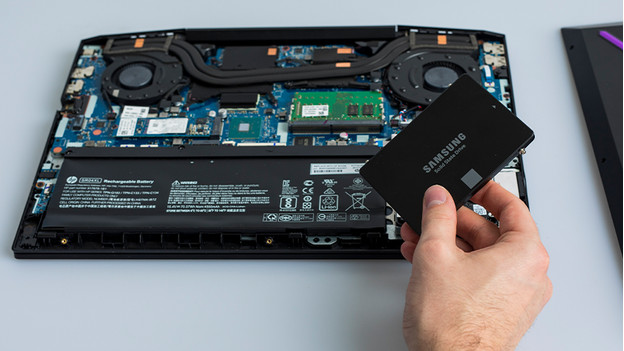- Loading...
Gaming laptops, the powerhouses of on-the-go gaming, offer an exhilarating experience for enthusiasts. However, navigating the plethora of options demands careful consideration. This guide is not just a run-of-the-mill tutorial; it's a strategic approach to ensure you make an informed decision and emerge victorious in the realm of gaming laptops.
GPU: The Core Element of Gaming

The linchpin of any gaming laptop is undeniably the Graphics Processing Unit (GPU). Nvidia and AMD are the juggernauts in this arena. Nvidia's RTX 40-series, ranging from RTX 4050 to RTX 4090, and AMD's RX 7000M and 7000S series, including RX 7600M and RX 7700S, dictate the landscape.
Choosing the Right GPU:
- Entry-level Gaming: For casual or older games at 1080p and 60 fps, opt for RTX 4050 or RX 7600M.
- Mid-range Marvels: Aim for RTX 4060 or RX 7700S for AAA games at 1080p and 60 fps or more.
- High-end Haven: If ultra settings at 1440p and 60 fps or more are your target, RTX 4080 or RX 7600S is the choice.
- Top-tier Territory: Embrace the RTX 4090 for gaming at 4K and 60 fps or more.
Considering factors like Max-Q or Max-P, power limits, and VRAM are crucial in tailoring your GPU choice to your gaming aspirations.
CPU: The Brain that Drives Gaming

Equally pivotal, the Central Processing Unit (CPU) propels the gaming experience. Intel's Core i9-12th Gen series and AMD's Ryzen 5000H series dominate the scene.
Selecting the Ideal CPU:
- Entry-level Efficiency: i5-11400H or Ryzen 5-5600H for casual or older games at 1080p and 60 fps.
- Mid-range Mastery: i7-11800H or Ryzen 7-5800H for AAA games at 1080p and 60 fps or more.
- High-end Heroics: i9-11900H or Ryzen 9-5900HX for ultra settings at 1440p and 60 fps or more.
- Top-tier Triumph: i9-12900HK or Ryzen 9-5980HX for 4K gaming at 60 fps or more.
Cores, threads, clock speed, turbo boost, and cache size are factors to weigh when matching your CPU to your gaming ambitions.
RAM: The Gaming Memory Vault

Random Access Memory (RAM) plays a pivotal role in multitasking during gaming sessions. DDR4 RAM with speeds up to 3200 MHz dominates the current gaming laptop landscape.
Navigating RAM Requirements:
- Casual Gaming: 8 GB for low to medium settings at 1080p and 60 fps.
- AAA Gaming: 16 GB for high to ultra settings at 1080p and 60 fps or more.
- Epic Gaming Adventures: 32 GB for ultra settings at 1440p and 60 fps or more.
- Top-tier Gaming: 64 GB for 4K gaming at 60 fps or more.
Some laptops allow RAM upgrades, providing flexibility for future enhancements.
Storage: The Repository of Gaming Glory

Storage options, specifically Solid State Drives (SSDs), dictate the pace and responsiveness of your gaming laptop.
Decoding Storage Requirements:
- Entry-level Storage: 256 GB or 512 GB for a few casual or older games.
- Mid-range Mastery: 1 TB for several AAA games and additional files.
- High-end Haven: 2 TB for extensive gaming libraries and multimedia.
Check if the laptop allows storage upgrades to future-proof your gaming rig.
Display: The Window to Gaming Realms

The display is your portal to the gaming universe, and its characteristics significantly impact the gaming experience.
Unveiling Display Considerations:
- Size Matters: Optimal sizes range from 15 to 17 inches, balancing portability and immersion.
- Resolution Realism: From 1080p for crisp visuals to 4K for unparalleled clarity, choose wisely based on your preferences.
- Refreshing Gameplay: Higher refresh rates, starting at 60 Hz, offer smoother gameplay.
- Response Time Reality: Lower response times, ideally 5 ms or less, ensure minimal ghosting.
- Panel Preferences: Choose between IPS for color accuracy, TN for response time, or VA for contrast.
- Brightness and Contrast: Strive for a balance between visibility and power consumption.
- Color Gamut and Adaptive Sync: Consider wider color gamuts for vivid visuals and adaptive sync for seamless gameplay.
Keyboard: The Command Center of Gaming

A gaming laptop's keyboard is not just a typing tool; it's your command center during intense gaming sessions.
Analyzing Keyboard Attributes:
- Layout Logic: Select a layout that aligns with your language and preference.
- Size and Ergonomics: Balance between size for comfort and weight for portability.
- Key Travel and Actuation: Optimal key travel (1.5 mm to 2 mm) and actuation force (50 g to 70 g) ensure responsive gameplay.
- Feedback Finesse: Choose between linear, tactile, or clicky feedback based on your preference.
For an immersive gaming experience, the keyboard is your direct connection to the virtual battleground.
Conclusion: Mastering the Art of Gaming Laptop Selection
In the intricate dance of gaming laptops, choosing the perfect one is an art. By meticulously understanding your gaming needs, budget, and preferences, you're not just buying a laptop; you're investing in an unparalleled gaming experience.
Watch Jarrod's video for more info.
